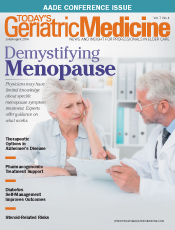
July/August 2014
Treatment Options for Stress Incontinence in Women Urgency, stress, and mixed incontinence affect approximately 20 million women, and while it’s not life threatening, incontinence significantly impacts health and quality of life. Odor and embarrassment may lead to social isolation, and fear of losing urine is correlated with avoiding exercise. Incontinence also leads to avoiding intimacy, given the high correlation between sexual activity and involuntary urine loss. In addition, many osteoporotic fractures in the geriatric population result directly from falling while attempting to reach the bathroom before losing urine. Stress incontinence is particularly problematic. The management of stress incontinence often is assumed to be the same as for urge and overactive bladder but requires unique and often underutilized approaches. The basic defect that occurs with stress incontinence is a funneling of the lower portion of the bladder. This occurs as a result of a lack of support of the urethra with a subsequent loss of the pubovesical angle. When intra-abdominal pressure increases with valsalva, vesicular pressure is higher than urethral pressure, resulting in the involuntary release of urine. Since most women do not report stress incontinence, the majority of the affected population is untreated. Approximately one-half of women who do report urine leakage to a health care provider are inadequately treated despite the number of effective nonsurgical and surgical treatment strategies currently available. Pads and protective garments commonly are recommended, but they should be thought of as a means to manage but not treat incontinence. In addition to the expense, which is not covered by Medicare and is covered in Medicaid only in some states, rarely do women find diapers or pads to be a welcome wardrobe accessory. However, most women are unaware they have options other than diapers, but several do exist. Treatment Options Obesity contributes to incontinence, and when women learn of obesity’s role in incontinence, it can provide significant motivation toward weight control. Smoking cessation and healthy voiding habits also impact the degree and frequency of incontinence. On the other hand, fluid restriction is not appropriate and can contribute to hypotension and dehydration. Treating stress incontinence with the use of a vaginal pessary is inexpensive and a potential option, but there is limited provider expertise in identifying, sizing, and placing the correct pessary. In addition, relatively few women, particularly younger women, will accept a pessary as a long-term solution. Many women find it useful to insert a pessary during exercise or as an adjunct to other treatment. Older women who are not capable of pelvic floor exercises, are not candidates for surgical intervention, have cognitive impairment, or reside in nursing homes also may find a pessary to be an acceptable solution. It is known that most cases of stress incontinence result from a weakened pelvic floor with subsequent inadequate support of the bladder neck and descent of the urethra. Coughing, laughing and, in severe cases, even change of position or walking can cause the descent of a poorly supported urethra, resulting in urine leakage. Kegel exercises are commonly recommended, and almost as commonly, they fail. Studies show that few women do them correctly or consistently. While there are a number of protocols, the basic regimen calls for six- to eight-second contractions done in three sets of eight to 12 per day for a minimum of three months. Young, highly motivated patients who work with a pelvic floor physical therapist are the most likely to experience success with these exercises. While there are a number of over-the-counter devices to facilitate the success of Kegel exercises, such as weighted cones and balls that the patient is instructed to hold in place during activity, there are no scientific studies that show efficacy of these devices. A recent random survey conducted by the author showed that only 20% of women were aware of the existence of pelvic floor physical therapy. The pelvic floor therapist uses several modalities, including biofeedback, bladder training, and pelvic floor muscle exercises. Electrical stimulation commonly is utilized to stimulate pelvic muscle contractions and/or modulate detrusor contractions. Such therapies include noninvasive electrical stimulation placed in the vagina or rectum or sacral nerve stimulation utilizing a surgically implanted electrode. While pelvic floor physical therapy and electrical stimulation have long been established as successful treatments for incontinence, few patients have access to a pelvic floor physical therapist or have adequate insurance coverage, and even if they do, they generally are not willing to commit to the time required for successful therapy. Indeed, only a small percentage of women utilize this option. Potential Solution Once placed in the vagina, InTone is inflated so its two electrode contacts rest against pelvic muscles. During 12-minute daily therapy sessions, a gentle electrical stimulation (a physician determines the appropriate level) enables the patient to learn to contract and relax her pelvic floor muscles. As the pelvic floor muscles gain strength and the detrusor muscles relax, the electrical stimulation gradually is increased. Daily sessions continue over a two- to four-month period, and once incontinence is eliminated, a maintenance program of one session per week keeps muscles toned. Surgery Obviously, surgery is costly, and recovery time is required. Many patients prefer surgery to other interventions or have failed conservative treatment, but excluding certain isolated situations, surgery should not be considered as a first-line intervention. — Lauren Streicher, MD, is an associate professor of obstetrics and gynecology at the Feinberg School of Medicine at Northwestern University in Chicago. She also is the author of Love Sex Again: A Gynecologist Finally Fixes the Issues That Are Sabotaging Your Sex Life, a consumer-friendly, comprehensive sexual health book that describes hormonal, medical, and physical problems that impact sexual function in women of all ages. Resources • American Urogynecology Association: www.voicesforpdf.org • Herman and Wallace Pelvic Rehabilitation Institute: www.hermanwallace.com • InTone: www.incontrolmedical.com • National Association for Continence: www.nafc.org |
